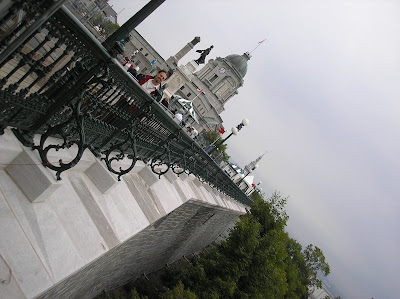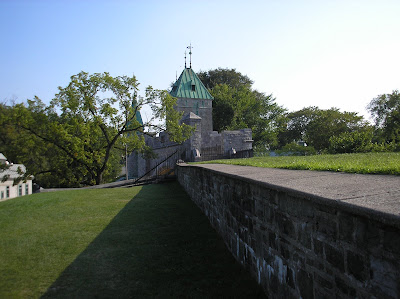Before relocating eastward, seasoned travel was surely not my specialty. No, great fear and absolute trepidation used to visit me, creating a rapid heartbeat with intense anxiety gripping my throat in a choke hold no one could sense from the naked eye. I was a chicken when it came to air travel, that’s for sure. Often friends would tease me about my white knuckle phobia, calming me down when sensing my upcoming relocation trip was creating such a thing. I had friends who prayed with me shortly before embarking on an air travel adventure, and here I am a complete wanderlust filled middle aged woman who has come to love travel like a favorite hobby.
Our recent trip to Old Quebec city was sparked initially from thoughts of accompanying my hubby for his business trip there. There have been and would continue to be several this year, but with winter fast approaching and fall colors quickly beginning to explode along country sides, autumn was the perfect time to go. Days were sunny and bright, evenings crisp and cool with frost warnings ringing through from Environment Canada.

Our bus trip ended up being two bus trips, one tour specifically focusing on the historical and detailed aspects of the city, and another later in the day touring the country including highlights on “Ile d’Orlean” up to the“Beaupre" coastal regions including a stop to the St. Anne de Beaupre Basilica at the farthest tip.
Birthplace of French America's families, the Côte-de-Beaupré represents the cradle of the of French families colonization. Known as the Route de la Nouvelle-France, the first Chemin du Roy was designed by Mgr de Laval in 1683. Everything from houses, cellars, churches, mills, farms unvail a rich architectural heritage dating back 400 years, bringing us back to the source of our ancestors, the first builders of Quebec..
Since we’d arrived in evening hours, we opted for only a bit of a stroll and bite to eat. Before any early morning exploration ideas came to pass on foot with map in hand, we were lucky enough to find the desired bus tours (city and country) of those available. Both had room to include the three of us right off the bat the very next morning. Why not? With reservation booking complete at the front desk, and knowing it would be a full day’s excursion for all, we all agreed on an early night and requested a wakeup call just in case we slept in a bit too much the next day.
Back in the hotel room, I couldn’t help but grin to myself with a mischievous thought when noting the telephone was sitting clear across the room from where my own bed was stationed, right next to the girls’ on one of their nightstand. Guess who would be answering the telephone the next day? Not moi!
Unlike myself, getting ordered and preparing for the early start ahead, I began setting out my clothes, packing my carry bag, and evaluating my own bathroom (scooping plan) head start timing. Both girls seemed to fly by the seat of their pants opting to wait until morning to prepare for the day ahead. I wondered how that was going to turn out.
Have you ever traveled with two older girls where only one bathroom was available to all? I figured if I wasn’t on deck and up out of bed first, this mama would not get into the bathroom at all. In fact, both girls learned how to share the bathroom vanity mirror, both using hair product and irons, makeup bags handy nearby or brushing their teeth and spitting at the same time in the sink directly below them.
Since I was a (forced) early bird, quickly ready in no time at all, I learned to ditch any impatience in the waiting game by heading out the door prior to the girls for the hotel’s main dining room area, to enjoy an early morning meal with a newspaper and hot cup of coffee.
Like us, other hotel patrons rose and shone in those early morning hours of our first and subsequent days, usually ready to depart on bus tours of their own, grabbing a bite to eat before their pick-up times.
Precisely at the designated hour, our tour bus driver arrived to shuttle everyone to the main bus tour boarding venue in the city center square next to the “Chateau” for the specific day’s tourists’ excursions. Our driver stood at bottom of the stairwell as everyone filed off the bus, pointing in the direction to bus number 2 for us – the city tour.
With some confusion we were sent to the wrong bus, until we were informed the office made an error in the booking. We re-boarded our original bus after all continuing on with the original driver. Problem by now was how full the bus was, so the girls took a double seat at the very back of the bus while I scooted in with another woman who was alone in the very front seat behind the bus driver. Ever try to take photos of a bus driver’s head? Not good.
Separated for this first bus tour all morning, I hoped the girls would be content with the situation and make the best of it. Are you kidding? They were just fine despite a rude tourist pointing his camera across their laps practically falling over them to snap photos from their windows with his 
 oto of him when he was unaware they weren’t really snapping photos out of the windows next to him.
oto of him when he was unaware they weren’t really snapping photos out of the windows next to him.
Highlights of the morning for me included the following, trying to keep things in some semblance of historical perspective, a feeble attempt no doubt as there is so much to learn about this first area where Jacques Cartier landed in 1534, though he did not settle here. On his second trip to the “New World”, he landed on “Iles d’Orleans”, naming it this after the second son of the King of France at that time.
When one thinks of Old Quebec, immediately thoughts of Samuel de Champlain come to min d for me, a man wearing lofty plume feathers from his large brimmed “chapeau” and costume signature clothing from the time period France was famous for. Champlain actually landed on this soil much later than Cartier in 1608 and the rest as they say...is history.
d for me, a man wearing lofty plume feathers from his large brimmed “chapeau” and costume signature clothing from the time period France was famous for. Champlain actually landed on this soil much later than Cartier in 1608 and the rest as they say...is history.
Constructing a fort to live within as a safe haven seemed to be the priority for Champlain and the entourage of settlers to come, hoping for bright futures in the fascinating folklore buzzing about French lands about this wonderful “New World” on Canadian soil.
Evidence of the fortifications of the city are everywhere
The original fort was enclosed and surrounded within natural and manmade grand fortress walls. Originally there were six gates into the city, all later destroyed. Four have since been rebuilt and are now the pillars to the area where tourists know- “We’ve arrived in old Quebec territory”
Huge vertical rock walls still surround the city today, cannons and army buildings evident almost everywhere.
Champlain chose the perfect spot to build his settlement and fort. Situated on the mountainside 350 feet above the St. Lawrence Seaway, just 80 miles north of the US border, the Appalachian Mountains can be viewed on a clear day. The waters in the seaway below are not salt water here; much to our surprise salt water doesn’t affect this region until thirty miles east of the city.
 The French setters felt safe here, claiming the area for the King of France until 1769 when 4000 English soldiers silently climbed the walls of “Gilmour Cliff”
The French setters felt safe here, claiming the area for the King of France until 1769 when 4000 English soldiers silently climbed the walls of “Gilmour Cliff”  during the middle of the night, positioning themselves into battle alert once daybreak appeared. Their General Wolfe waited to give commands to overtake the city with this surprise attack imminent before them; however it was the French General Montcalm who first gave orders to attack in an attempt to protect the city. The battle ended quickly but not without the deaths of 600 other soldiers and both Generals who also succumbed to their injuries this day. A large monument is situated in the area a commemoration to Montcalm still standing to this day.
during the middle of the night, positioning themselves into battle alert once daybreak appeared. Their General Wolfe waited to give commands to overtake the city with this surprise attack imminent before them; however it was the French General Montcalm who first gave orders to attack in an attempt to protect the city. The battle ended quickly but not without the deaths of 600 other soldiers and both Generals who also succumbed to their injuries this day. A large monument is situated in the area a commemoration to Montcalm still standing to this day.
Obviously the English took claim over of the area for the King of England during this battle, and subsequent battles continued to claim victory over this perfect spot. On December 31st, 1775 American General Richard Montgomery died in battle.
Ten years later in 1779, over 900 valiant fighters died with the English claiming victory again. In the years to come, American and Canadian armies joined forces to protect the land from future overzealous invaders hoping to capture such a well suited geographically situated gem. A large monument of Joan of Arc was gifted to the city to commemorate the dead during this battle, honoring valiant soldiers who fought here to defend the city.
Joan of Arc
Canons surround the city walls to this day

Originally the French built a wall around the city, but years later the English increased the wall, eventually taking over twelve years to build their citadel which was completed in 1832. However, though the English claimed victory at that time, they later allowed the French to vote and continue on with their customs and lifestyles. To this day it’s still known as a French land by heritage; customs from those early days still dominating everywhere, yet all of Canada is of course part of the English commonwealth in our modern timeline.
Still, The Fortifications of Quebec City were erected under both the French and English regimes in order to safeguard the city. Recognized as a World Heritage Site, Québec is the only historic district in North America to have preserved its ramparts. Today, the numerous bastions, gates, and defense works still encircle the old city.
Currently a team of Archaeologists are continuing to comb and study an area just in front of the Chateau Frontenac noting evident changes between original French and English built areas, defining them well by studying the engineering techniques used by each during this individual time periods when they each reined the land.
Archeology digs are currently in progress
A vast area of the boardwalk is torn up, leaving anyone a full visual below to the archaeology work in progress. Tours are actually encouraged to see what they’ve accomplished thus far with guides to enhance the learning.
Walking where others walked before us
It’s simply fascinating to me to be able to walk on this historical ground where settlers were once filed into ships with barbaric conditions as they sailed in droves, hopeful over their future in the “New World”, docking directly below this very site all those years ago. Like any explorer or early settler, I’m fairly certain try as we might, we remain hardly able to relate to the myriad of tales they have woven over many years for us to absorb the big picture of the normalcy of their lives back when. But we learn from those who came before us, studying how they lived, what they were like and who they were.
For sure, like a step back in time, walking those Cobblestone streets, observing cafes with unscreened windows thrown open to the sidewalk, folks walking home with fresh baguettes and cheeses, table d’hôte service evident everywhere, all these things directly add to the ambiance and charm of this city, as do people speaking French, the language of the city and Belle Province.
Basilique-Cathedrale Notre Dame de Quebec
In 1633, on part of the actual site, a humble votive chapel dedicated to the Virgin was built by Samuel de Champlain. It was rebuilt three times after fire and destruction, always on the same site. Rebuilt, in 1647, as Notre-Dame-de-la-Paix, after the fire of 1640, it became North America’s first parish church and was solemnly consecrated by Mgr. de Laval in 1666.
Like all other Provinces within Canada, Quebec’s own Parliament buildings are situated outside of the fort area, standing architecturally grand and astute in all its splendor. The 19th-century, Louis XIV style Parliament Buildings are the home of the National Assembly of 125 province representatives.

The "Plains of Abraham" is now a city park
The battleground designated area has now become a beautiful public park and the fort is still actively used today by the Royal Regiment. During the summertime, tourists can enjoy watching the changing of the guard, an event filled with tradition and splendor. Sadly the very old army drill hall burned this past April/08, the entire center of it now charred ruins with original stone walls still standing erect surrounding it.
The Royal Regiment still uses the Fort today
The O Canada was first performed at the first French-Canadian Catholic Congress on June 24, 1880, Saint Jean Baptiste Day. On that occasion, a contest was planned for the creation of a hymn, someone having suggested that the performance of a great national song should highlight the the celebration. It was apparently also sung at the Quebec skating club on the Plains of Abraham.
 During winter time the park is filled with snow and never ploughed. Instead it becomes a part of 35,000 miles of snowmobile and cross country ski trails and a new season of daily commuting for the local folks. No doubt this postcard activity reigns supreme in the park along with the commuting; this past winter, over 20 feet of snow fell onto the city, so there is no joke in owning a snowmobile here, everyone does. Our friends said there was so much snow last winter, when they looked down their streets, front yards were packed high with snow, so high in fact that the rooftops were not visible to someone venturing down the street. Snow dumps were made to handle all the extra snow removal, never placed in the sea.
During winter time the park is filled with snow and never ploughed. Instead it becomes a part of 35,000 miles of snowmobile and cross country ski trails and a new season of daily commuting for the local folks. No doubt this postcard activity reigns supreme in the park along with the commuting; this past winter, over 20 feet of snow fell onto the city, so there is no joke in owning a snowmobile here, everyone does. Our friends said there was so much snow last winter, when they looked down their streets, front yards were packed high with snow, so high in fact that the rooftops were not visible to someone venturing down the street. Snow dumps were made to handle all the extra snow removal, never placed in the sea.
The oldest armory building still stands. It was thought then if iron shutters were closed and bolted, all of the money in the city within in would be protected.
The Artist Alley was intriguing and enticed visitors to view the works of the local artists. I loved this area! We went there every day and felt like we were in Paris most certainly.
Artists' Alley
Funicular --- Built in 1683, this historic home below belonged to Louis-Jolliet, a Quebec-born explorer. Today it houses the lower platform of the funicular, an elevator type ride from Le Petit Champlain district to the Chateau area high above.
Flags; And of course, throughout Quebec, the flag below was everywhere, right next to the Canadian Flag and a special flag commemorating Samuel de Champlain.
I'll be back with more yet....from our country tour...





.jpg)





































